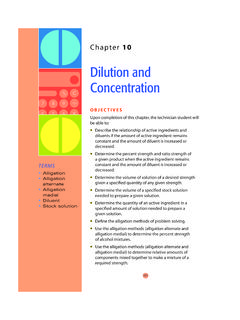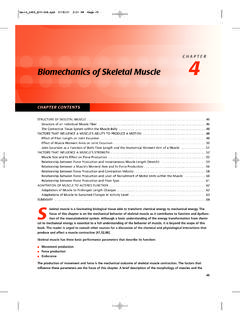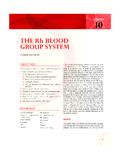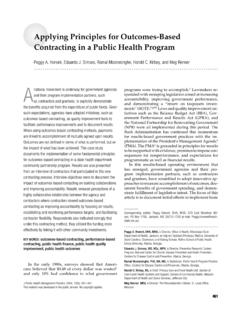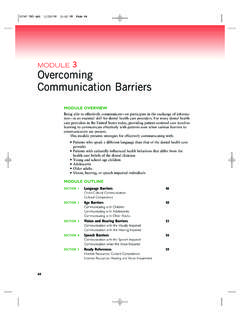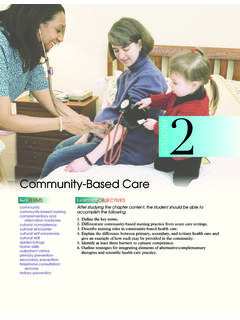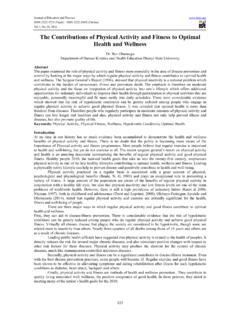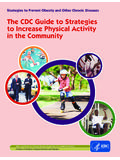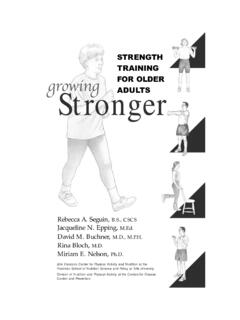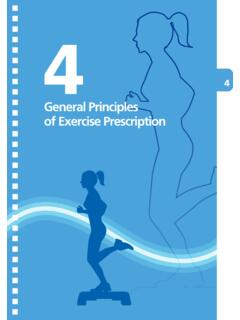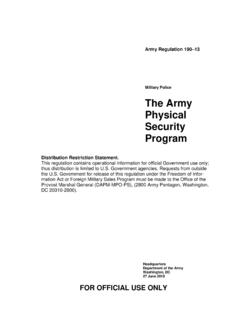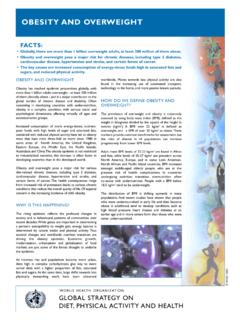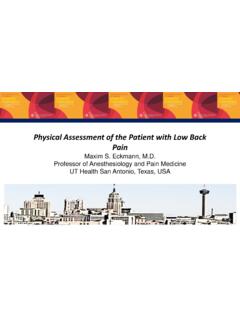Transcription of Preparticipation Health Screening and Risk Stratification
1 18 Numerous physiologic, psychologic, and metabolic Health /fitness benefits resultfrom participation in regular physical activity . As illustrated in Chapter 1, how-ever, there are documented risks associated with physical activity . Althoughthere is risk of acute musculoskeletal injury during exercise, the major concernis the increased risk of sudden cardiac death and myocardial infarction that issometimes associated with vigorous physical exertion. A major public healthgoal is to increase individual participation in regular, moderate-to-vigorousphysical activity . Pursuit of this goal must include a process for identifying indi-viduals at increased risk for adverse exercise-related events. At the same time,the risk stratification process should not present a significant barrier to partici-pation. This chapter presents guidelines for (a) evaluating an individual s riskfor adverse exercise-related events and (b) making appropriate recommenda-tions regarding the initiation, continuation, or progression of an individual sphysical activity program to reduce the potential occurrence of these types ofcatastrophic participants should be screened for the presence, signs, symptoms,and/or risk factors of various cardiovascular, pulmonary, and metabolic diseasesas well as other conditions ( , pregnancy, orthopedic injury) that require spe-cial attention (16,18,19) to (a) optimize safety during exercise testing and (b) aidin the development of a safe and effective exercise prescription.
2 The purposes ofthe Preparticipation Health Screening include the following: Identification of individuals with medical contraindications for exclusionfrom exercise programs until those conditions have been abated or are undercontrol Recognition of persons with clinically significant disease(s) or conditionswho should participate in a medically supervised exercise program Detection of individuals at increased risk for disease because of age, symp-toms, and/or risk factors who should undergo a medical evaluation and exer-cise testing before initiating an exercise program or increasing the frequency,intensity, or duration of their current program Recognition of special needs of individuals that may affect exercise testingand programmingPreparticipation HealthScreening and RiskStratification 10/20/08 11:25 AM Page 18 Aptara stratification procedures initially take into consideration whether individu-als are guiding themselves through the process or are consulting a healthcare or fit-ness professional.
3 The self-guided individual will most likely need a relatively sim-ple tool and decision-making process to determine if his or her risk is elevated tothe extent that a physician should be consulted before initiating a physical activityprogram, particularly if the intended exercise intensity is vigorous (1,6,7). A Health -care or fitness professional should have a logical and practical sequence for gather-ing and evaluating an individual s Health information, assessing risk, and providingappropriate recommendations about additional Screening procedures and physicalactivity recommendations ( , the Frequency, Intensity, Time, and Type or FITT framework; see Chapter 7). The American College of Sports Medicine (ACSM) pro-vides guidelines for risk stratification in this chapter, but recognizes guidelines forrisk stratification published by other organizations such as the American HeartAssociation (AHA) (1,12,18,19) and the American Association of Cardiovascularand Pulmonary Rehabilitation (AACVPR) (4).
4 Exercise and Health /fitness profes-sionals should also be familiar with these other guidelines when establishing indi-vidual and program-specific policies for Preparticipation Health Screening and med-ical clearance, particularly for populations with known cardiovascular SCREENINGP reparticipation Screening procedures and tools must be valid, providing relevantand accurate information about the individual s Health history, current medicalconditions, risk factors, signs/symptoms, current physical activity /exercise habits,and medications. Another consideration is the literacy level of the instrumentused to obtain this information ( , participant education level and language).SELF-GUIDED Screening FOR physical ACTIVITYA self-guided Screening for physical activity program is initiated and guided bythe individual with little or no input or supervision from an exercise or Health /fitness professional.
5 Individuals seeking to start a physical activity program ontheir own may have questions about whether it is appropriate and safe to do , they need an easy-to-use Screening tool to guide them through theprocess. At the most basic level, participants may follow the recommendation ofthe Surgeon Generals report on physical activity and Health (1996) (23): pre-viously inactive men over age 40 and women over age 50, and people at high riskfor cardiovascular disease (CVD) should first consult a physician before embark-ing on a program of vigorous physical activity to which they are unaccustomed. The participant may also use a self-guided questionnaire or instrument such asthe physical activity Readiness Questionnaire (PAR-Q; Fig. ) (9) or theAHA/ACSM Health /Fitness Facility Preparticipation Screening Questionnaire(Fig. ), which serves to alert those with elevated risk to consult a physician(or other appropriate healthcare provider) before participation (6,7).
6 Other types of self-administeredsurveys that may be incorporated into theexercise Screening process include (a) routine paperwork completed within thescope of a physician office visit, (b) entry procedures at Health /fitness or clinicalCHAPTER 2 Preparticipation Health Screening and Risk 10/20/08 11:25 AM Page 19 Aptara FOR EXERCISE TESTING physical activity Readiness (PAR-Q) Form. (Source: physical activity Readi-ness Questionnaire [PAR-Q], Public Health Agency of Canada and the Canadian Societyfor Exercise Physiology, reproduced with the permission of the Minister of Public Worksand Government Services Canada, 2007).exercise program facilities, and (c) physical activity promotional materialsdesigned for and distributed to the general public. When a participant completesa self-guided instrument and medical clearance is recommended from the ques-tionnaire results, participants should consult their physician and obtain clearancebefore participation in a physical activity /exercise program.
7 For self-guided 10/20/08 11:25 AM Page 20 Aptara 2 Preparticipation Health Screening and Risk Stratification21 Assess your Health status by marking all truestatementsHistoryYou have had:_____ a heart attack_____ heart surgery_____ cardiac catheterization_____ coronary angioplasty (PTCA)_____ pacemaker/implantable cardiac defibrillator/rhythm disturbance_____ heart valve disease_____ heart failure_____ heart transplantation_____ congenital heart diseaseSymptoms_____ You experience chest discomfort with exertion_____ You experience unreasonable breathlessness_____ You experience dizziness, fainting, or blackouts_____ You take heart Health issues_____ You have diabetes_____ You have asthma or other lung disease_____ You have burning or cramping sensation in your lower legs when walking short distances_____ You have musculoskeletal problems that limit your physical activity_____ You have concerns about the safety of exercise_____ You take prescription medications_____ You are pregnantCardiovascular risk factors_____ You are a man older than 45 years_____ You are a woman older than 55 years, have had a hysterectomy.
8 Or are postmenopausal_____ You smoke, or quit smoking within the previous 6 months_____ Your blood pressure is 140/90 mm Hg_____ You do not know your blood pressure_____ You take blood pressure medication_____ Your blood cholesterol level is 200 mg/dL_____ You do not know your cholesterol level_____ You have a close blood relative who had a heart attack or heart surgery before age 55 (father or brother) or age 65 (mother or sister)_____ You are physically inactive ( , you get 30 minutes of physical activity on at least 3 days per week)_____ You are 20 pounds overweight_____ None of the aboveaProfessionally qualified exercise staff refers to appropriately trained individuals who possess academic training, practical and clinical knowl-edge, skills, and abilities commensurate with the credentials defined in Appendix you marked any of these statements in this section, con-sult your physician or other appropriate Health care providerbefore engaging in exercise.
9 You may need to use a facilitywith amedically qualified should be able to exercise safely without consulting yourphysician or other appropriate Health care provider in a self-guided program or almost any facility that meets yourexercise program you marked two or more of the statements in this sectionyou should consult your physician or other appropriatehealth care provider before engaging in exercise. You mightbenefit from using a facility with a professionally qualifiedexercise staffato guide your exercise AHA/ACSM Health /Fitness Facility Preparticipation Screening Questionnaire(Modified from American College of Sports Medicine Position Stand and American HeartAssociation. Recommendations for cardiovascular Screening , staffing, and emergencypolicies at Health /fitness facilities. Med Sci Sports ;30(6):1009 18.) 10/20/08 11:25 AM Page 21 Aptara regimens conducted at low ( 40% oxygen update reserve ) tomoderate (40% 60% ) exercise intensity, little additional assessment isneeded beyond the ACSM/AHA Questionnaires (1), provided that one adheres toall medical clearance recommendations contained within the form.
10 Such regi-mens should incorporate the physical activity recommendations from the General (6,23). A specific self-guided exercise regimen suitable for pre-viously sedentary individuals may be found in the ACSM Fitness Book (6).PROFESSIONALLY GUIDED Screening FOR physical ACTIVITYP rofessionally guidedimplies that the Health fitness/clinical assessment is conductedby and the exercise program is designed and supervised by appropriately trainedpersonnel who possess academic training and practical/clinical knowledge, skills,and abilities commensurate with the credentials defined in Appendix D. Self-guided surveys are effective in identifying individuals who would benefitfrom medical consultation before participation in an exercise program (1). A moreadvanced process administered by professionally trained personnel provides greaterdetail regarding CVD risk factors and signs/symptoms and identifies a broader scopeof chronic diseases and/or conditions that need special consideration before engag-ing in an exercise program.
